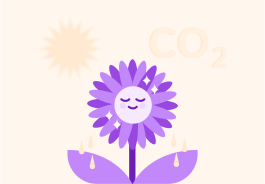YOU ARE LEARNING:
How Photosynthesis Works

How Photosynthesis Works
You will learn to describe photosynthesis in terms of its reactants and products.
Photosynthesis is an amazing process that plants and algae can carry out. For photosynthesis to occur, energy must be available in which form?

Photosynthesis is a reaction that occurs in plants and algae. Photosynthesis means using light energy (photo) to make products (synthesis), photosynthesis only occurs when there is light energy available.
A reaction can be described as exothermic, where energy is released, or endothermic where energy is required for the reaction to take place. Now, photosynthesis requires light. What type of reaction do you think photosynthesis is?

Light energy is required for photosynthesis to occur. Two other substances are also required by the plant so that it can photosynthesize. These are called reactants. See if you can work out what the reactants for photosynthesis might be... or simply have a guess!

Two products are made directly in photosynthesis. Use any knowledge you already have to identify or simply guess what you think these could be. Remember the elements that make up the products must already have existed in the reactants.

You can select multiple answers
So plants need carbon dioxide and water to react together in photosynthesis. Light energy must be required for the reaction to occur, and during the reaction the plants make glucose and oxygen.
There is an equation for photosynthesis. Reactants are written on the left of the arrow. Products are written on the right. Select the correct word equation for photosynthesis.

The equation for photosynthesis can be also be written using chemical formulae. The trickiest formula is glucose so remember this one straight away C6H12O6 . Remember that it can only be made from the elements available in carbon dioxide and water: Carbon C, hydrogen H and oxygen, O.
The chemical formula for glucose is C6H12O6 . You may know the chemical formulae for some of the other compounds involved in photosynthesis so try and work out which symbol equation is correct. Don't worry yet about balancing it.

Which equation for photosynthesis is correctly balanced? You can have a guess by adding up the numbers of each elements on the left and on the right, if the numbers each side of the arrow are the same, the equation is balanced.

The correctly balanced symbol equation for photosynthesis is this:
6CO2+6H2O→C6H12O6+6O2
The plant uses up the glucose C6H12O6 , or stores any it does not need immediately, but the oxygen O2 is released as a waste product of this reaction. Other living organisms are of course very grateful for that. Without oxygen we would suffocate!
